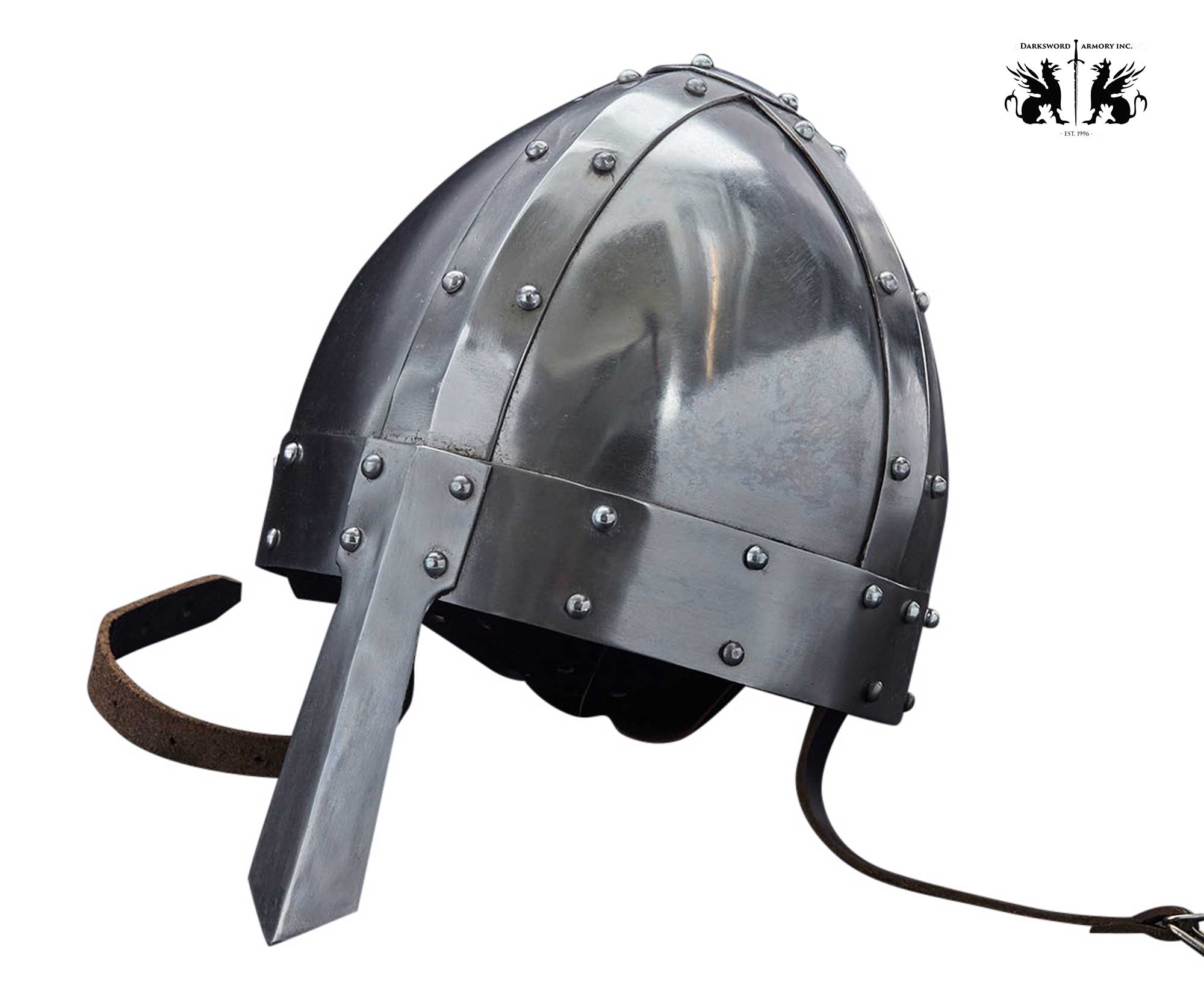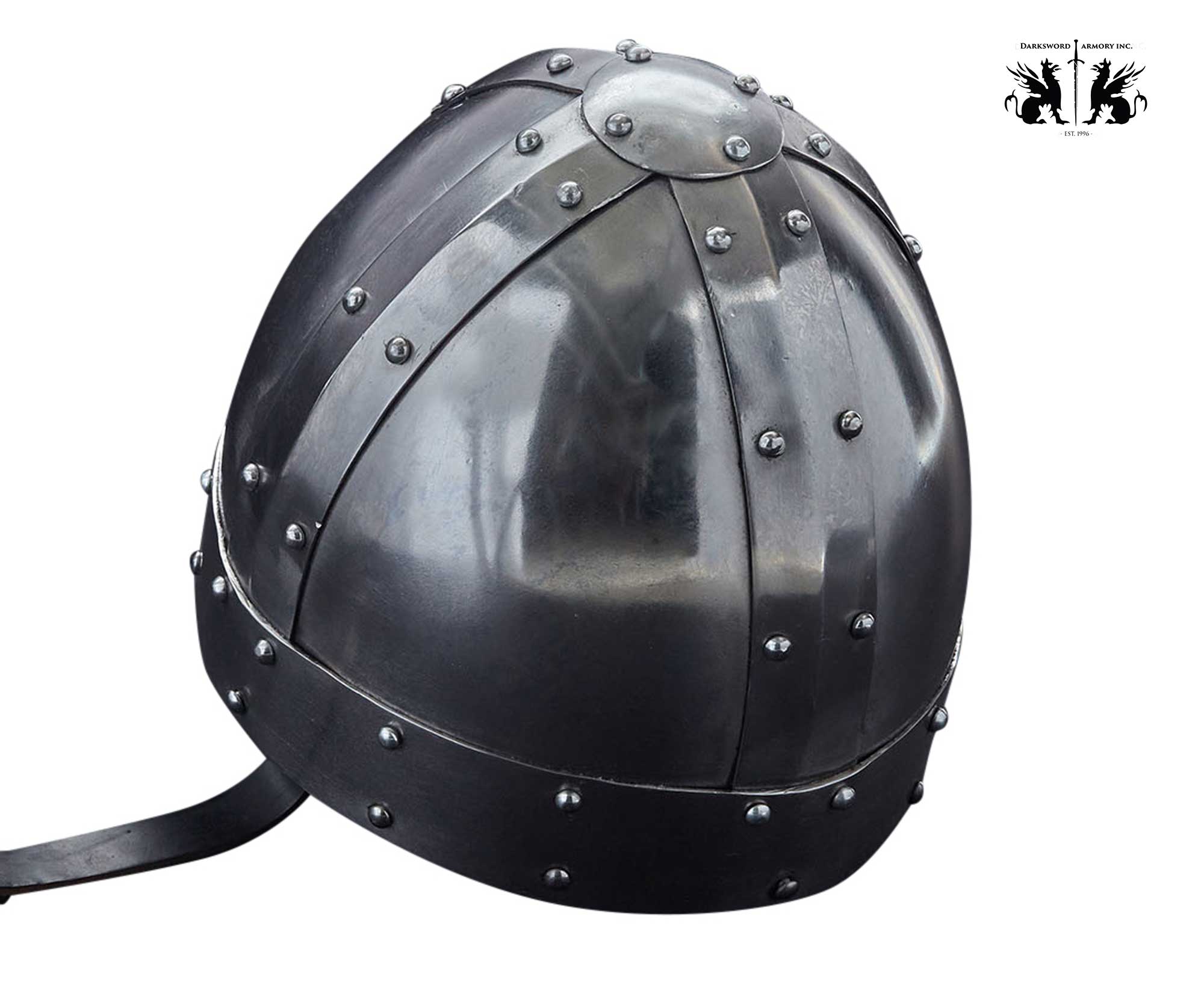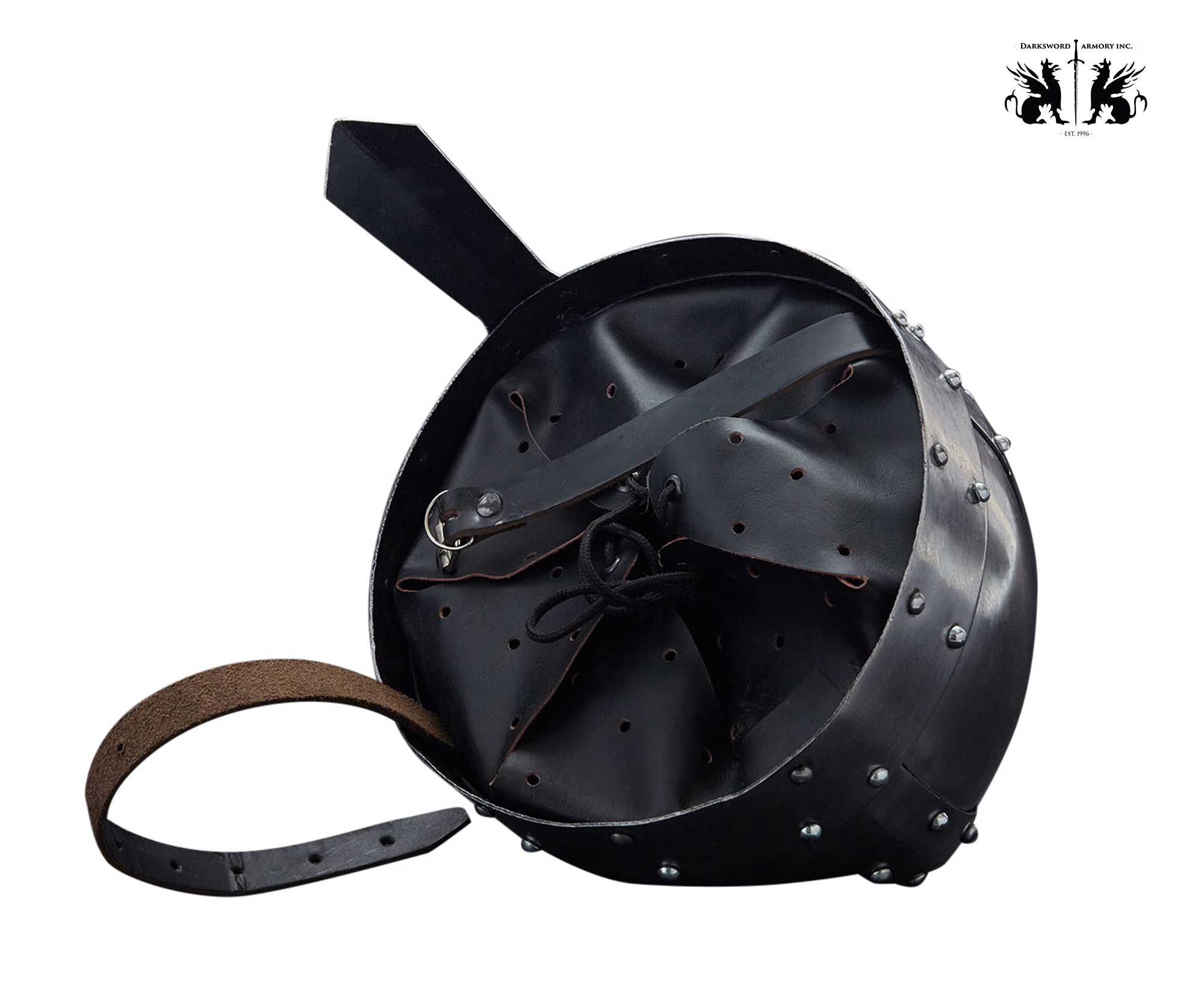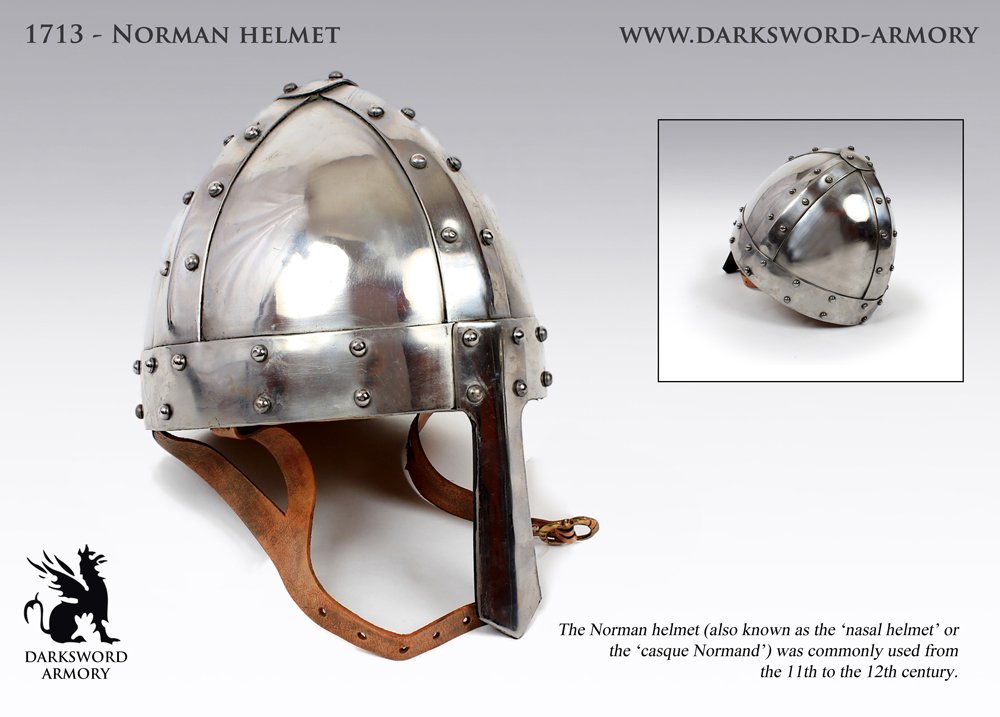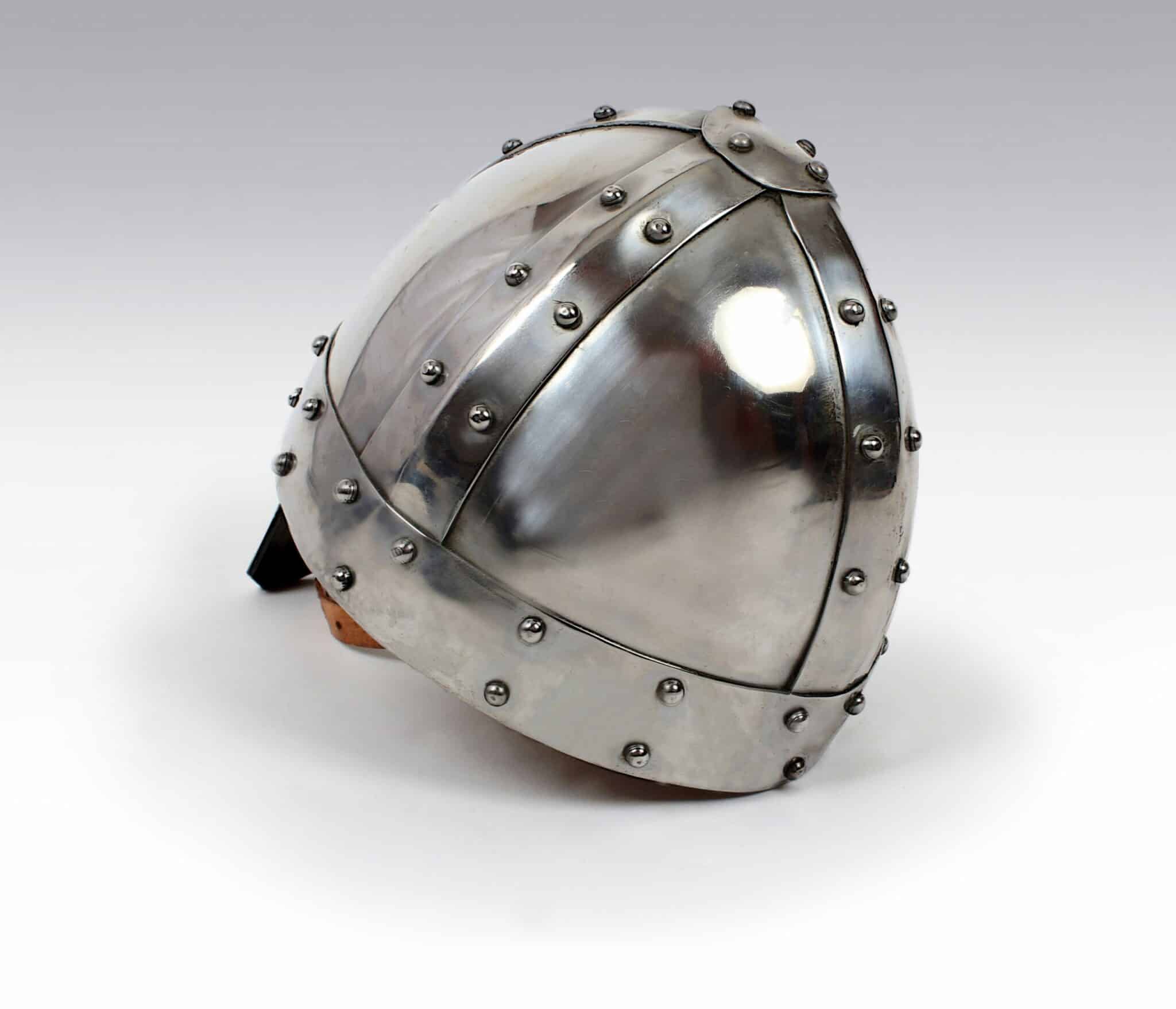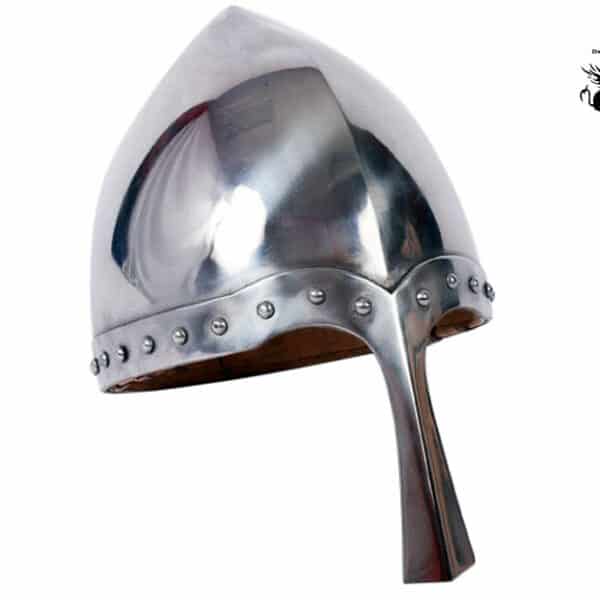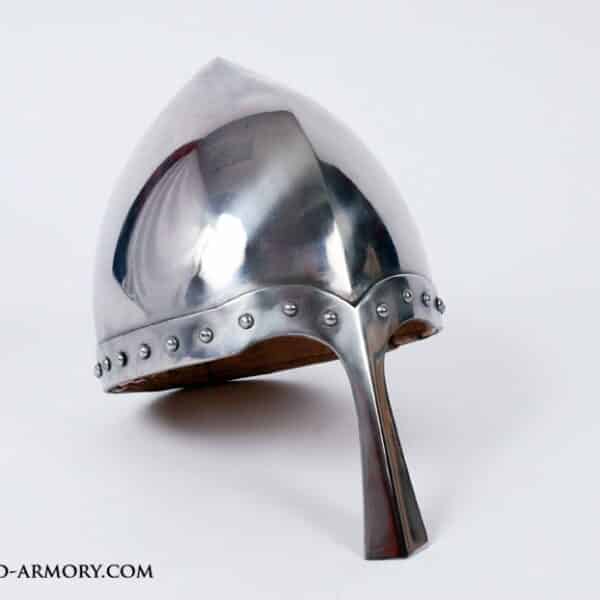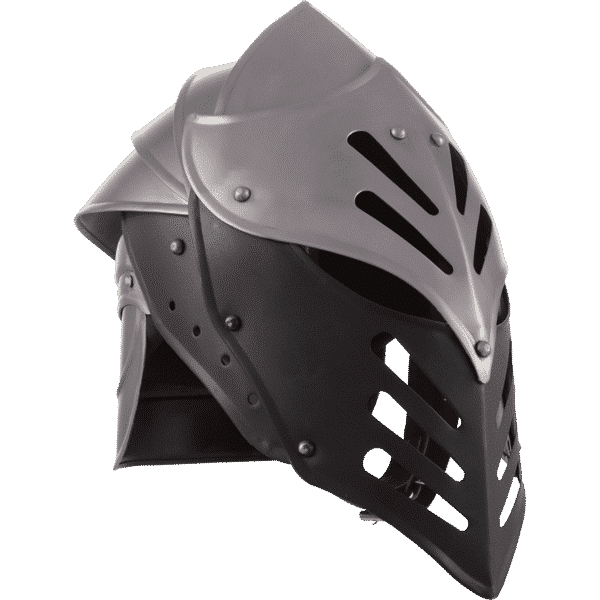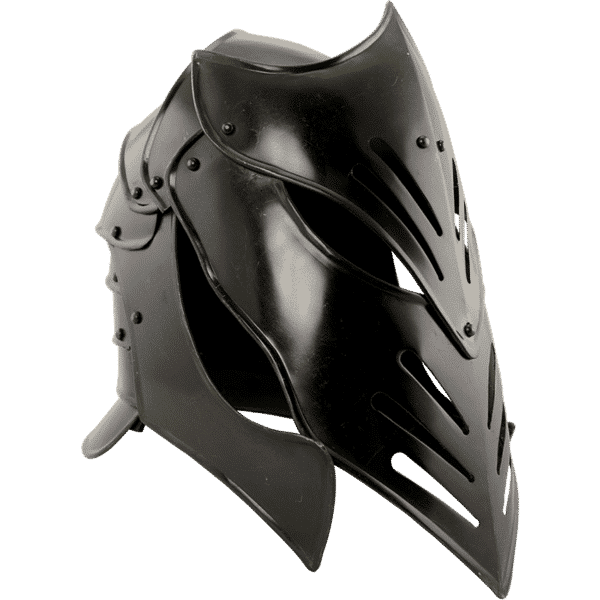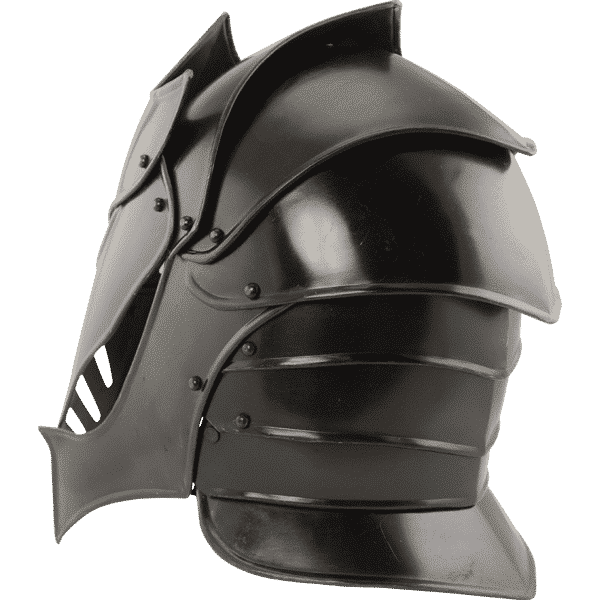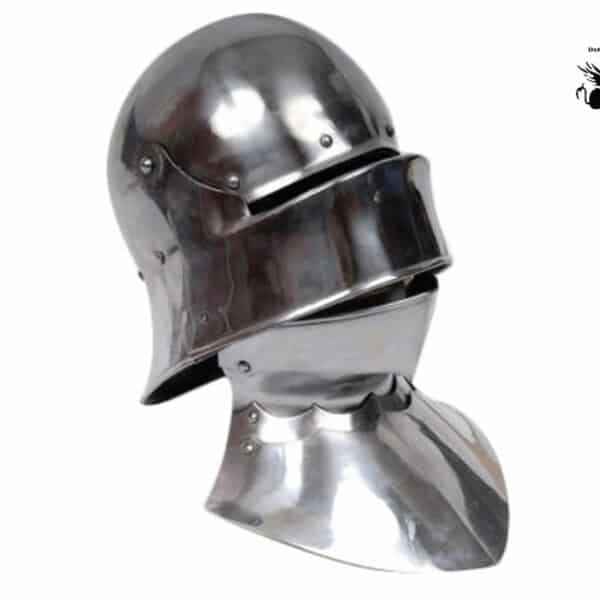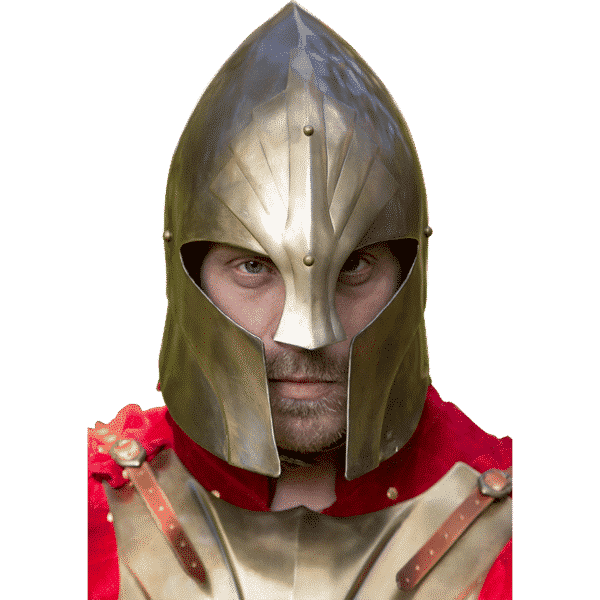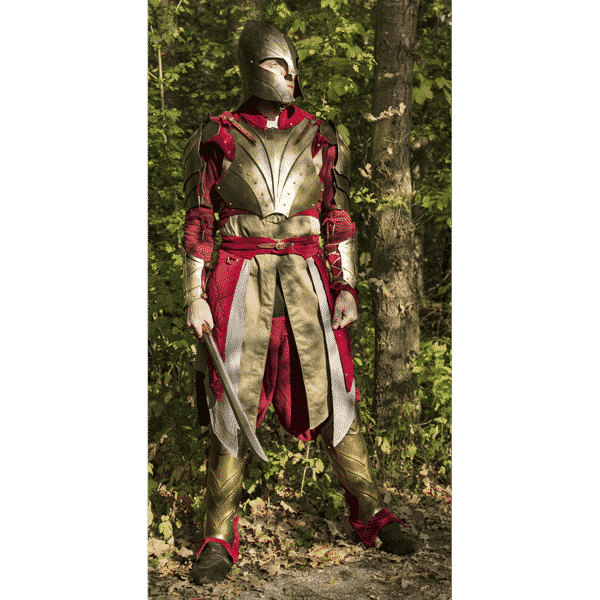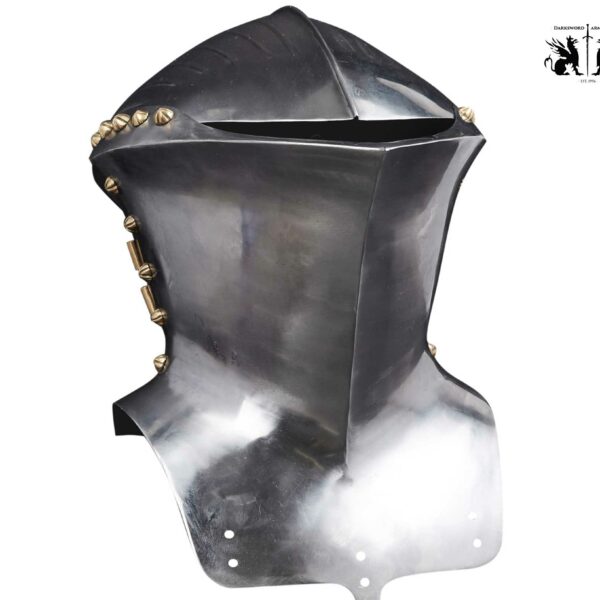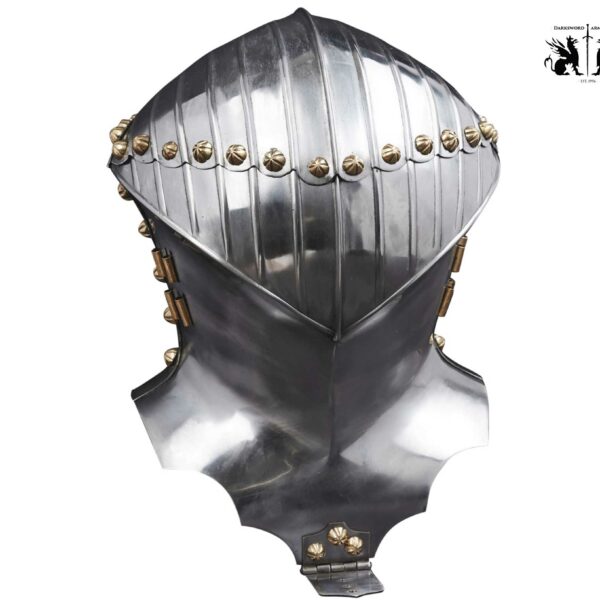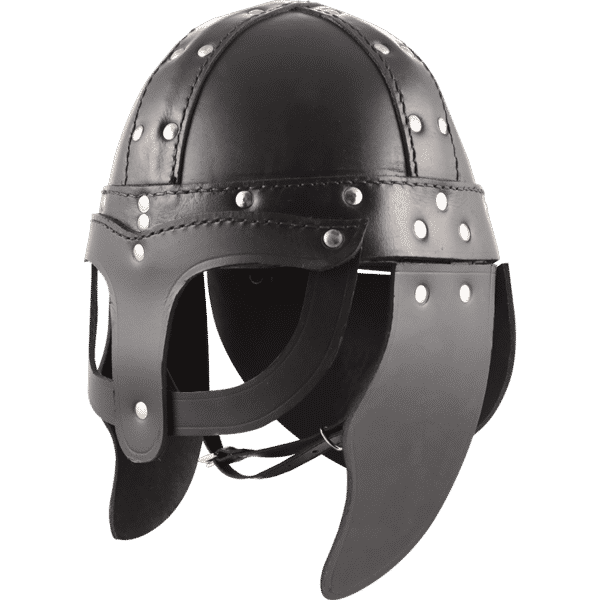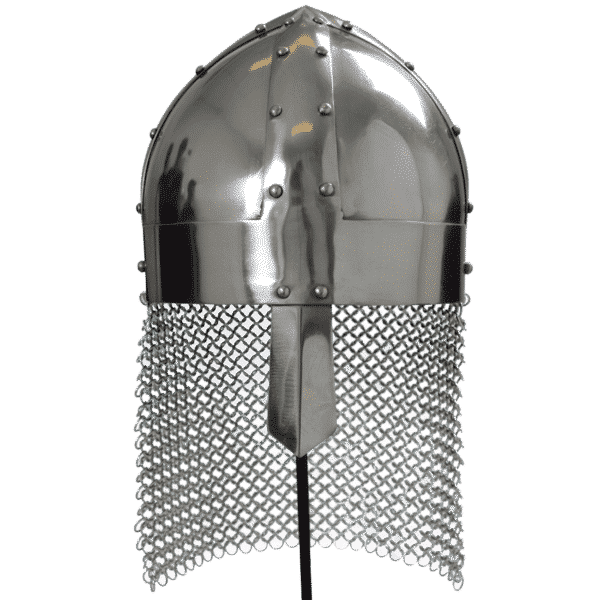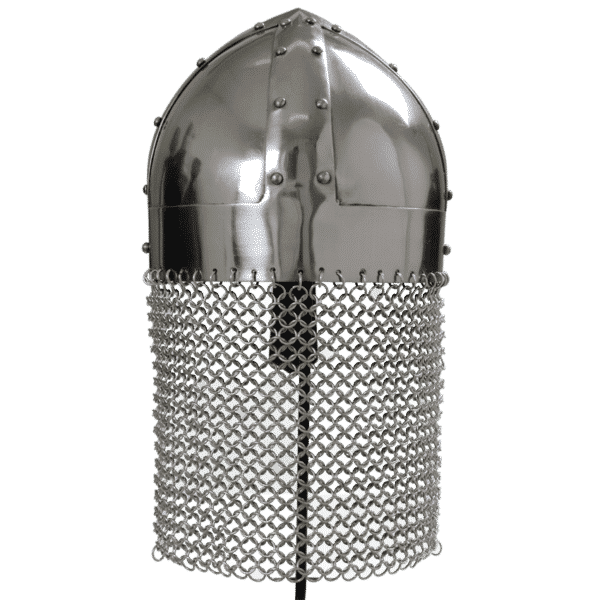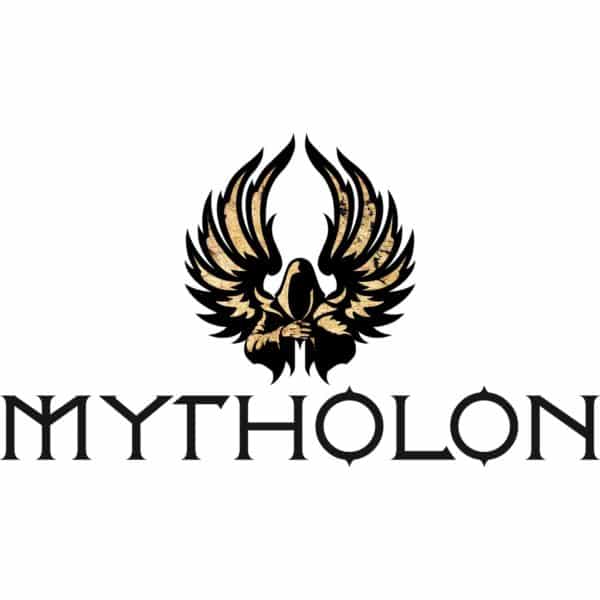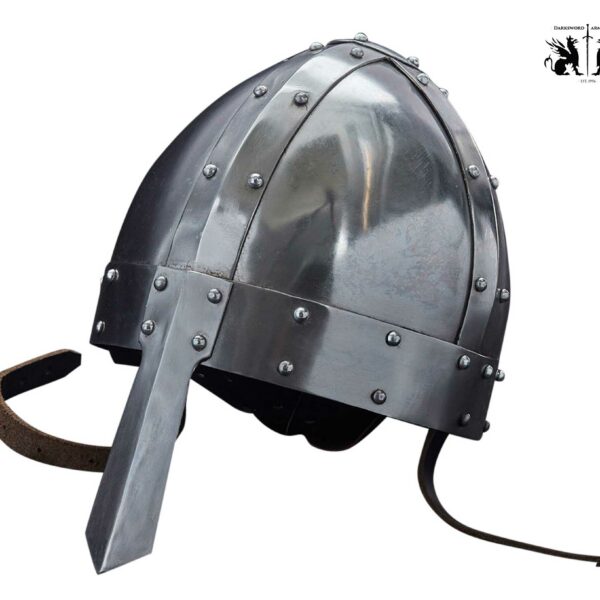Norman Helmet
(About): A Germanic Spangenhelm for a Conquering Norman Noble
Our Norman Helmet is a peerless historical reproduction of one of the most recognisable helmets of the medieval era: the ‘nasal helmet’, worn by William the Conqueror at the Battle of Hastings in his conquest of the English throne. The Norman nasal helmet has deep roots in Dark Age Europe, stretching all the way back to the days of Rome, and its use in warfare for more than half a millennium speaks to the simplicity and effectiveness of its design. Canada’s finest artisanal maker of medieval arms and armor Darksword Armory has worked from the rich historical record, studying documentary evidence, Middle Ages art, and the handful of surviving examples, to reproduce a stunning Norman nasal helm. The result is a fantastic re-enactment-grade Norman Helmet that will see you through the fiercest of Anglo-Saxon shield walls. You can mix-and-match it with any of our range of high-quality Norse armor for a fearsome head-to-toe outfit!
Steel Yourself
Darksword Armory’s master smiths have chosen 14-gauge steel to make our Norman Helmet. Helmets were arguably the earliest form of plate armor – ancient peoples had realised long ago that the head was a critically important body part to protect, and so invested most heavily in head defenses. 14-gauge mild steel is an excellent historical analogue for the sturdy metal plate construction of historical Norman helmets. This 2mm-thick carbon steel is likely much better than the historical helmets, which would have been made from less effective wrought iron; our Norman Helmet will do sterling service protecting you from the hard knocks of simulated combat, re-enactment and roleplay.
If It Ain’t Broke: Battle-Tested Reliability
The Norman Helmet is a simple, effective design. It is a Germanic spangenhelm in construction, made from four quarter-dome plates united by a hand-riveted, slightly conical steel frame. The helmet’s iconic nasal guard is broad and effective, riveted to the brow of the helmet. This characteristic defense of course gives the helmet its name, and they were surprisingly effective in battle. One account of the Battle of Hastings recounts a moment when rumour spread through the Norman lines that William, the putative Conqueror of England, had fallen – and he was forced to stand up tall in his stirrups and remove his helmet to show that he was unharmed. This moment is depicted in the Bayeux Tapestry. The nasal guard of his Norman helmet must therefore have been prodigious if it was enough to obscure his identity! This form of facial defense provides an excellent field of vision, and it remained popular throughout the High Medieval era, developing into the bretache in the late Crusader period, surviving well into the 14th-century CE.
All The Mod-Cons
As well as excellent authentic historical design, our Norman Helmet is made to be a user-friendly piece of re-enactment or roleplay equipment. It is secured with a robust, adjustable leather strap with a chunky buckle to secure it. The interior of the helmet has a leather suspension system – whereas in the medieval period most soldiers would likely have stuffed your helmet with straw or moss, Darksword Armory have designed an innovative drawstring system that keeps your helmet on your head and properly placed to absorb the worst.
Our Norman Helmet is a triumph: unfussy, four-square and effective, it is a perfect analogy for the Norman people, whose cross-Channel empire dominated medieval Western Europe for more than a century, shaping the course of all that would follow until the present day. Our Norman Helmet is a perfect way to depict an Early- or High Middle Ages warrior or knight, whether in the context of faithful historical re-enactment, or as an inspired fantasy outfit for roleplay. The Norman Helmet was often worn over a mail coif, particularly in the later period – so make sure you browse our selection of chainmail head protection.
(History): Who Were the Normans?
Most people could tell you that the Normans conquered England in 1066, installing Duke William of Normandy as King William I the Conqueror. But what has gone neglected by popular history is that the scale of Norman influence on Europe only grew from there. At their height in the 1130s CE, the Normans were the Kings of England, founders of the Kingdom of Sicily and rulers of the southern half of Italy, Crusader Kings in the Holy Land, subduers of the Iberian peninsula and lords of North Africa. Books have been written about the meteoric success of the Duchy of Normandy, its people and its unique social and military culture – but to get a brief sense of the people who wore the Norman helmet, we shall have a whistle-stop tour of Norman Europe.
Roots in the North
The Norman people can be traced back to the 9th century CE, when Norse raiders from Scandinavia began to incur further and further up the waterways of north-western Frankia (modern-day France). By the late 800s CE, they were threatening Paris – and in 885, Odo of Paris successfully defeated a concerted Viking invasion under the Danish king Sigfred. Thereafter, a shrewd and effective Viking leader of uncertain origin called Rollo emerges as leader of Viking raids into the interior of France. Eventually, the well-organised Franks began to turn the tide against the raiders – and in 911, they forced Rollo to come to terms. Rollo’s price was steep. He would be willing to convert to Christianity and stop his raids, even swearing allegiance to the Frankish crown – but only if King Charles ceded a large tract of coastal land in the north-western county of Neustria to the Northmen, and made Rollo into a Duke. Seeing no other way to end the raids, Charles acceded – and thus the Duchy of Normandy was born: literally, ‘the land of the men from the North’.
Normandy and Italy
The Norman culture was born of the Scandinavian settlers intermarrying with the local Franks and creating a fusion of their heritages, building the Norman language from the indigenous Gallo-Romance tongue. The former-Vikings adopted feudal forms similar to the rest of Frankia. They also took with great gusto to the Carolingian traditions of horsemanship. This, combined with the relative poverty of their Duchy, meant that the Norman aristocracy became fearsome warriors characterised by heavy armored cavalry. But old habits die hard, and Norman bands still travelled abroad to acquire new lands. By the start of the second quarter of the 11th century, they had established a toehold on the Italian peninsula, founding the Sicilian state by a combination of settlement and blackmail, in much the same way as Rollo had done a century before.
The Conqueror
The Norman martial tradition came in extremely handy when Rollo’s fourth-great-grandson William the Bastard set his sights on exploiting the tottering Anglo-Saxon state across the Channel… Although William’s own heritage was less than clear (hence his epithet), Norman steel did a lot of the talking for him. The Anglo-Saxon Kingdom of England had been undergoing a see-sawing crisis for several decades by the time of the death of Edward the Confessor, and it was only internal opposition to his rule within Normandy that had prevented William from exploiting the crisis any sooner. But William finally launched his claim against the English throne in September 1066, crossing the channel in full battle-array, ready for a hard-fought contested landing, and faced… nothing. By staggering coincidence, Edward Godwinson’s half-brother had made a play for the throne at exactly the same moment, crossing from Denmark and landing in Northumbria two days previously. Despite having to defeat the Danes and then march the entire length of the country to meet William, Godwinson very nearly defended his claim to the English throne – but his shield wall was picked apart by Norman archers and that elite heavy cavalry at the Battle of Hastings. Over the following decade, King William I secured his claim on the throne with an iron fist, one particularly brutal campaign against rebellious Northumbrians and Mercians being forever known as ‘the Harrying of the North’.
By the late 11th century, the Normans were a prime power in Europe, holding the Duchy of Normandy, the crown of England and a big chunk of southern Italy. As well as forming a key contingent of the Crusades, the Norman law and architecture they spread would define the medieval for generations to come.
(History): Spangenhelms
Our Norman Helmet is built using an authentic historical technique of helmet construction known as the spangenhelm. Historical spangenhelms were made by beating four or six small metal plates into a curve, and then riveting them together onto a framework made from steel bands – or spangen, in German. This can be contrasted with other methods of constructing helmets from the period, such as beating a dome-shape from a single large sheet of metal, or by the ‘ridge helmet’ method, which united two half-domes with a tall connecting ridge from brow to nape. The spangenhelm method was extremely popular because it did not require high-quality materials: the multiple dome plates could be made relatively small and thick, united by the long bands – a series of simple processes well within the skill of your average blacksmith, rather than the highly skilled process of an armorer shaping a whole dome from one piece.
Spangenhelms became one of the most popular forms of helmet in Dark Ages Europe, appearing throughout Germanic, Viking, Anglo-Saxon and Frankish contexts, particularly where poorer-quality iron would have necessitated a more economical form of helmet design. But the origin of the spangenhelm is far more ancient. Its earliest examples originate all the way out on the Eurasian steppes amongst Iranian people such as the Sythians and Sarmatians, nomadic peoples who inhabited southern Russia and Ukraine during the later years of the Roman Empire. A gradual process of settling and political integration drew the Sarmatians in particular into settled life on the borders of Roman Europe, where many became foederati, Roman client peoples who were paid to police the Roman border provinces. They brought their language, culture and their innovative helmets with them into the Roman military, and thus spread them elsewhere when they were periodically called upon to deploy elsewhere. It proved to be wildly popular; the kinds of material scarcity and military challenges faced by Northern European were broadly similar to those faced by the Sarmatians – the need to create a cheap, easy to manufacture head protection with inferior-quality iron, against enemies armed primarily with cutting and stabbing weapons. Thus, by the 6th-century CE, Northern European Germanic peoples such as the Vendels, Angles and Saxons had adopted wholesale an Iranian helmet design from halfway across the known world.
As time went on, the drawbacks of the spangenhelm construction became apparent. Their multi-part construction was not enormously robust, with separate iron plates vulnerable to being split apart by heavy blows from axes or similar bludgeoning weapons. This was somewhat alleviated by the innovation of a tall ridge or point in the shape of the dome, which would deflect downward blows away from the head. But by the time of the Norman conquests, better alternatives had begun to become commonplace. Many Norman helmets with the long nasal projection would have been of the ‘broad-band’ type, a tall conical helmet beaten from a single piece of iron, with a wide metal band around the rim for strength, the nasal defense either riveted to it or made as part of the band. These would have been significantly better helmets – but they would have also been more expensive, requiring greater skill to manufacture, and thus would have been more likely to have been accessible to the wealthier knights and nobles. However, primary sources show us quite clearly that the spangenhelm construction remained common amongst Norman soldiers: clear depictions of multi-part spangenhelm types are shown worn by both Anglo-Saxon and Norman soldiers on the Bayeux Tapestry.
The spangenhelm was the direct ancestor of all of the instantly recognisable medieval helmets. The brim was broadened out to make a kettle hat; the nasal plate was joined to the cheek guards to make enclosed helmets and eventually the Crusader’s great helm. It is an integral part of Norman military history, and demonstrates their critical position as shapers of the medieval world.
Technical Specifications:
Material: 14-gauge steel
Secondary material: Leather
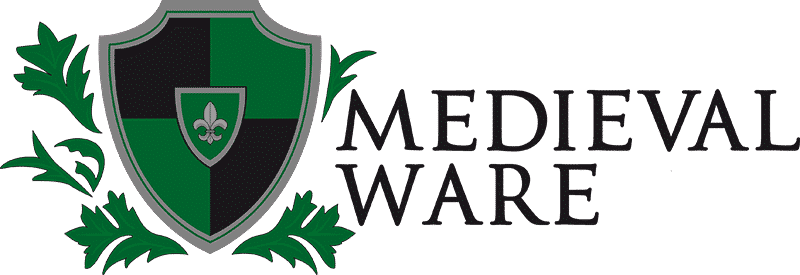
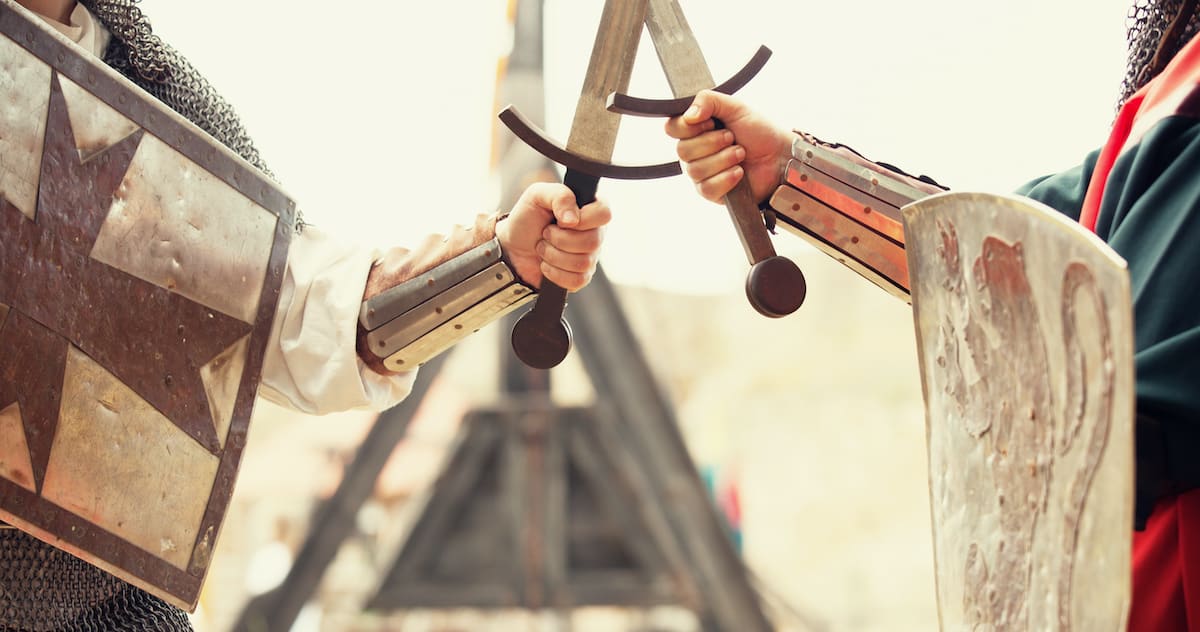 Historical Swords
Historical Swords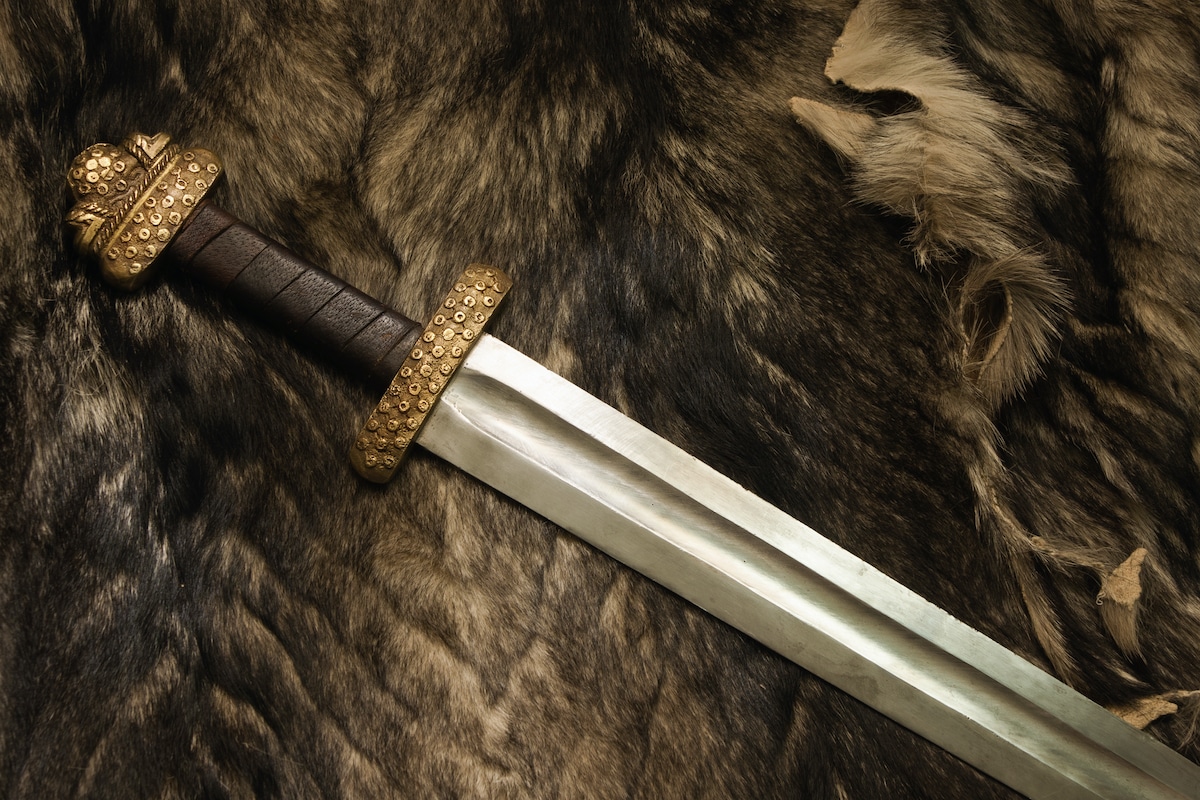 Norse & Viking Swords
Norse & Viking Swords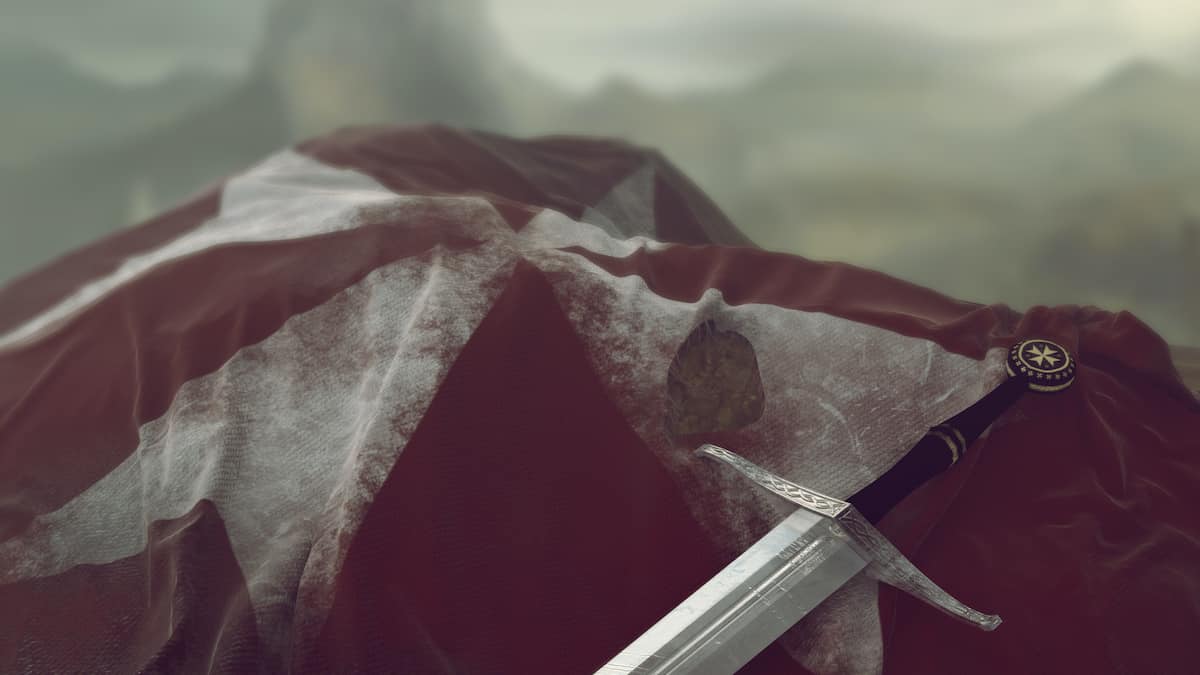 Templar Swords
Templar Swords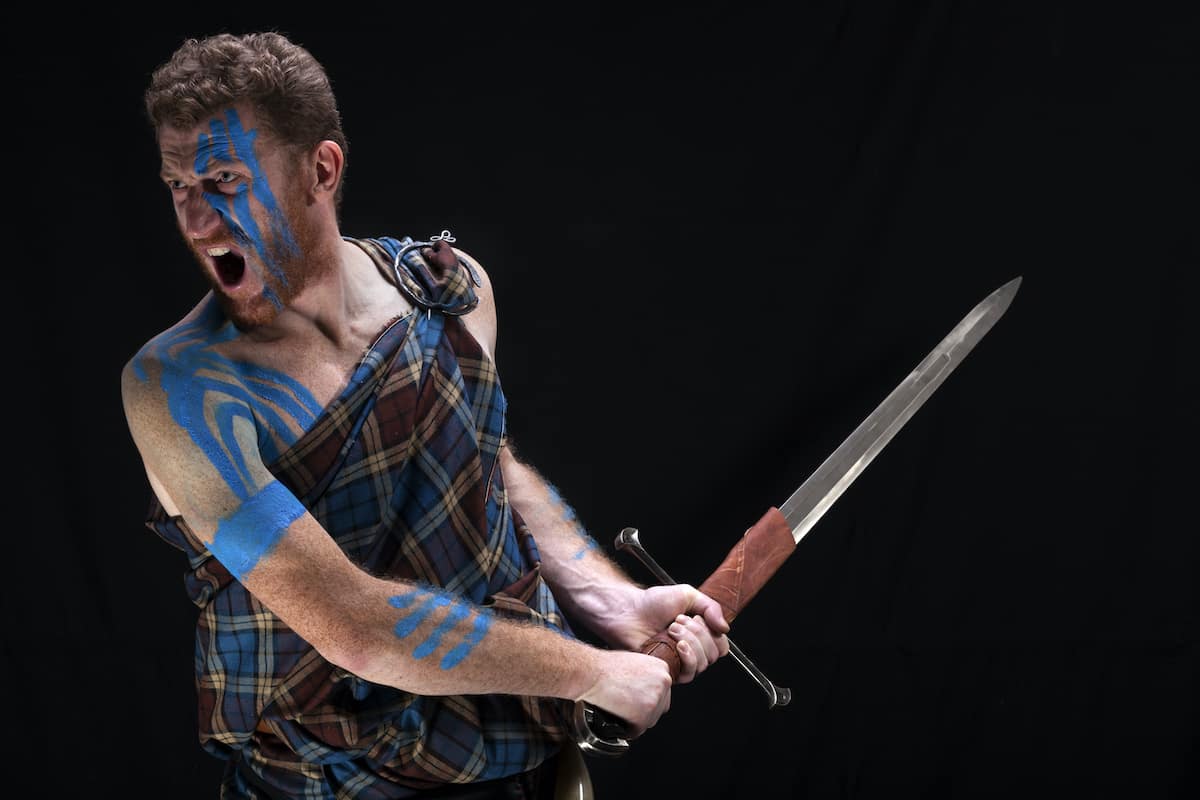 Claymore Swords
Claymore Swords Fantasy Swords
Fantasy Swords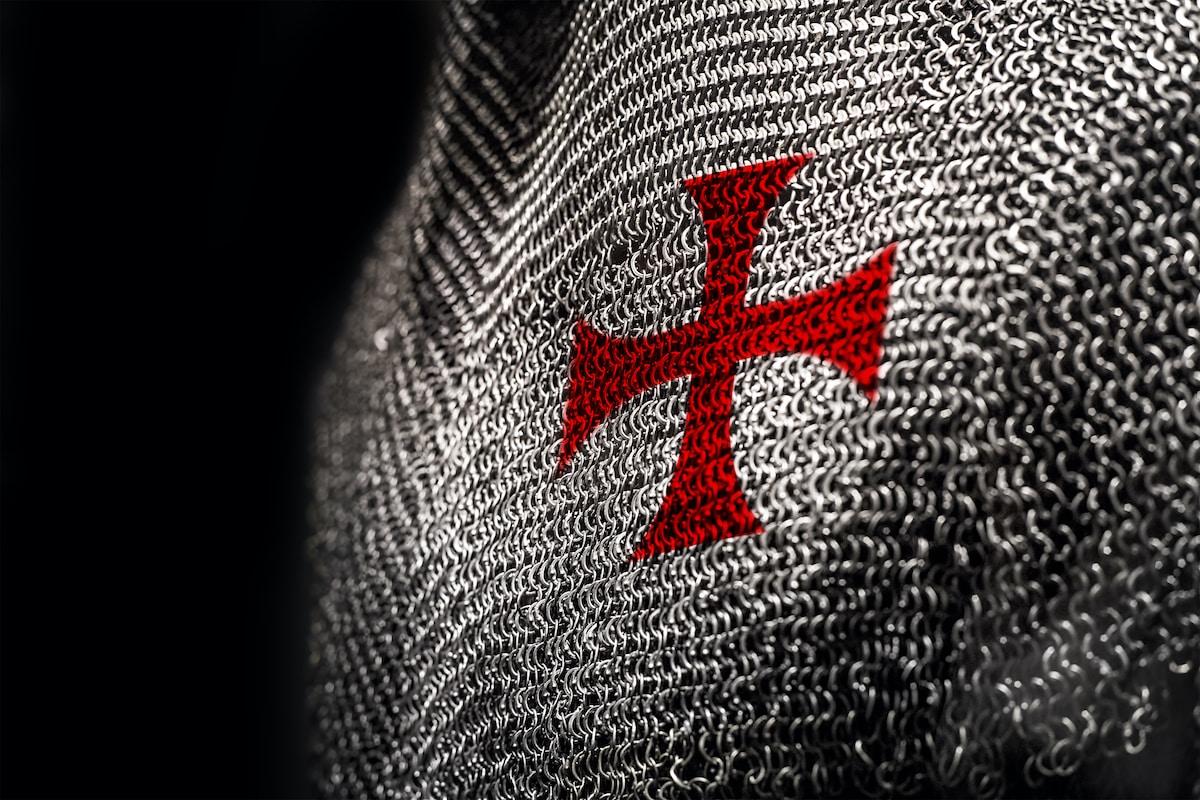 Chainmail
Chainmail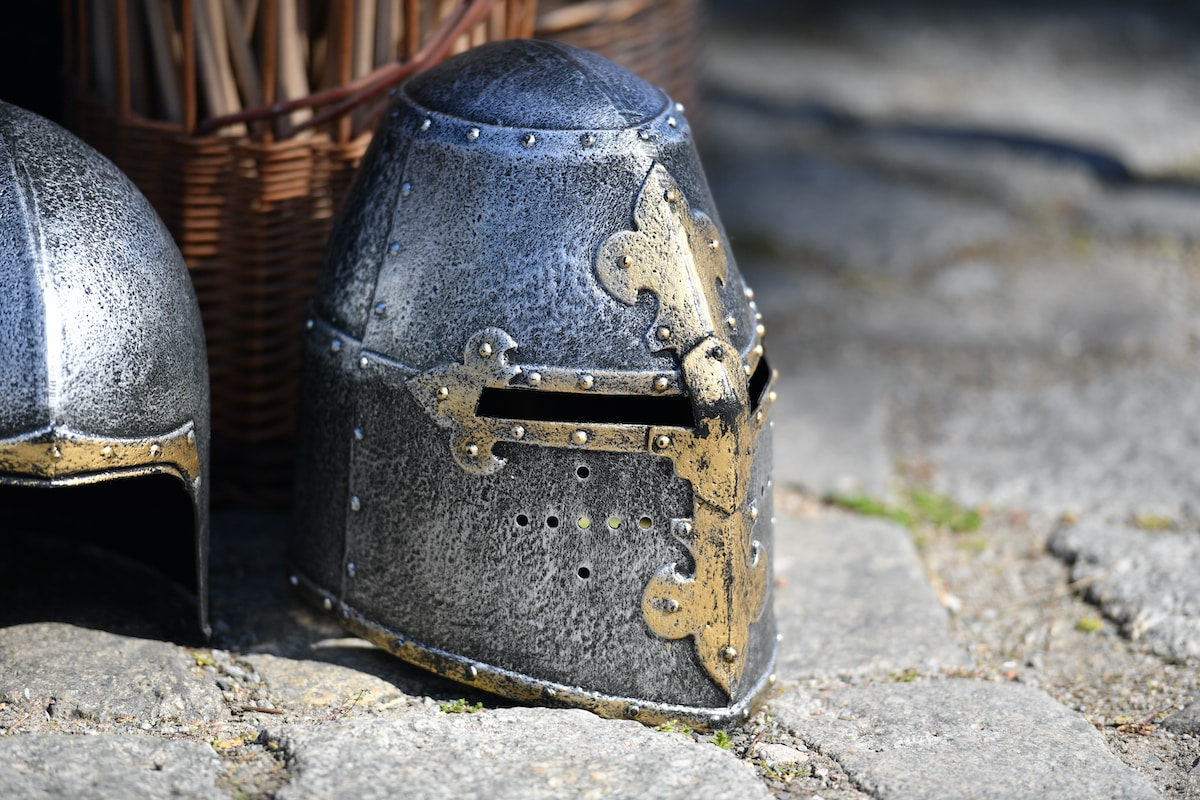 Helmets
Helmets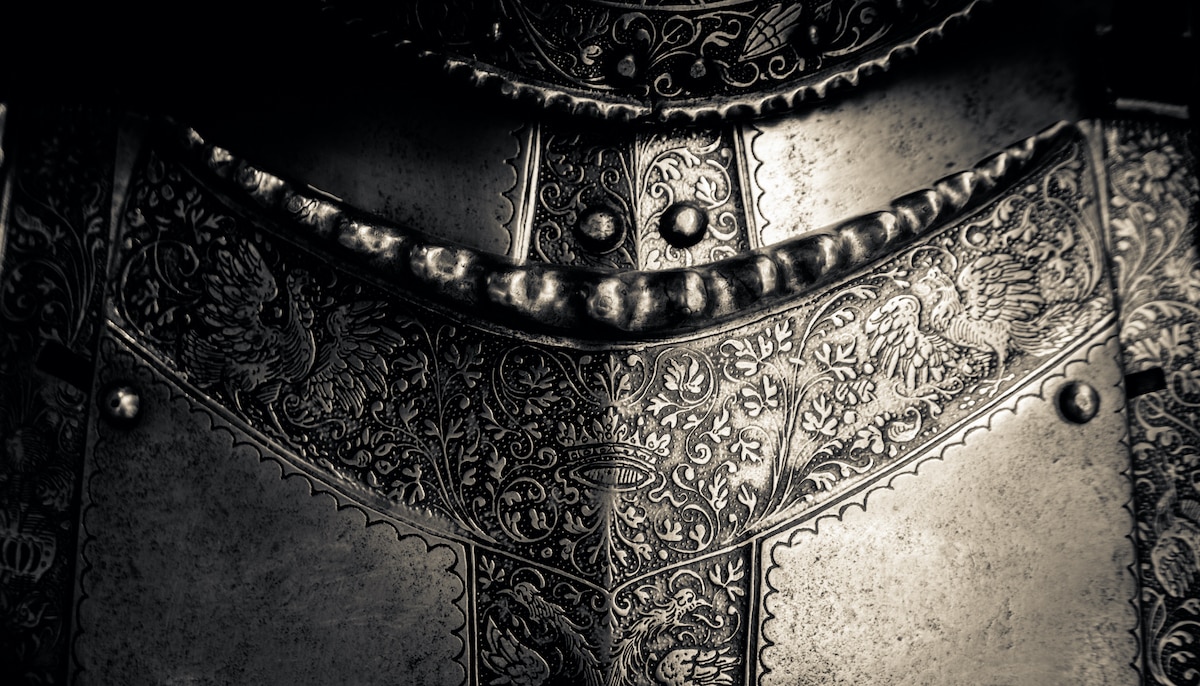 Torso Armor
Torso Armor Bracers and Arm Protection
Bracers and Arm Protection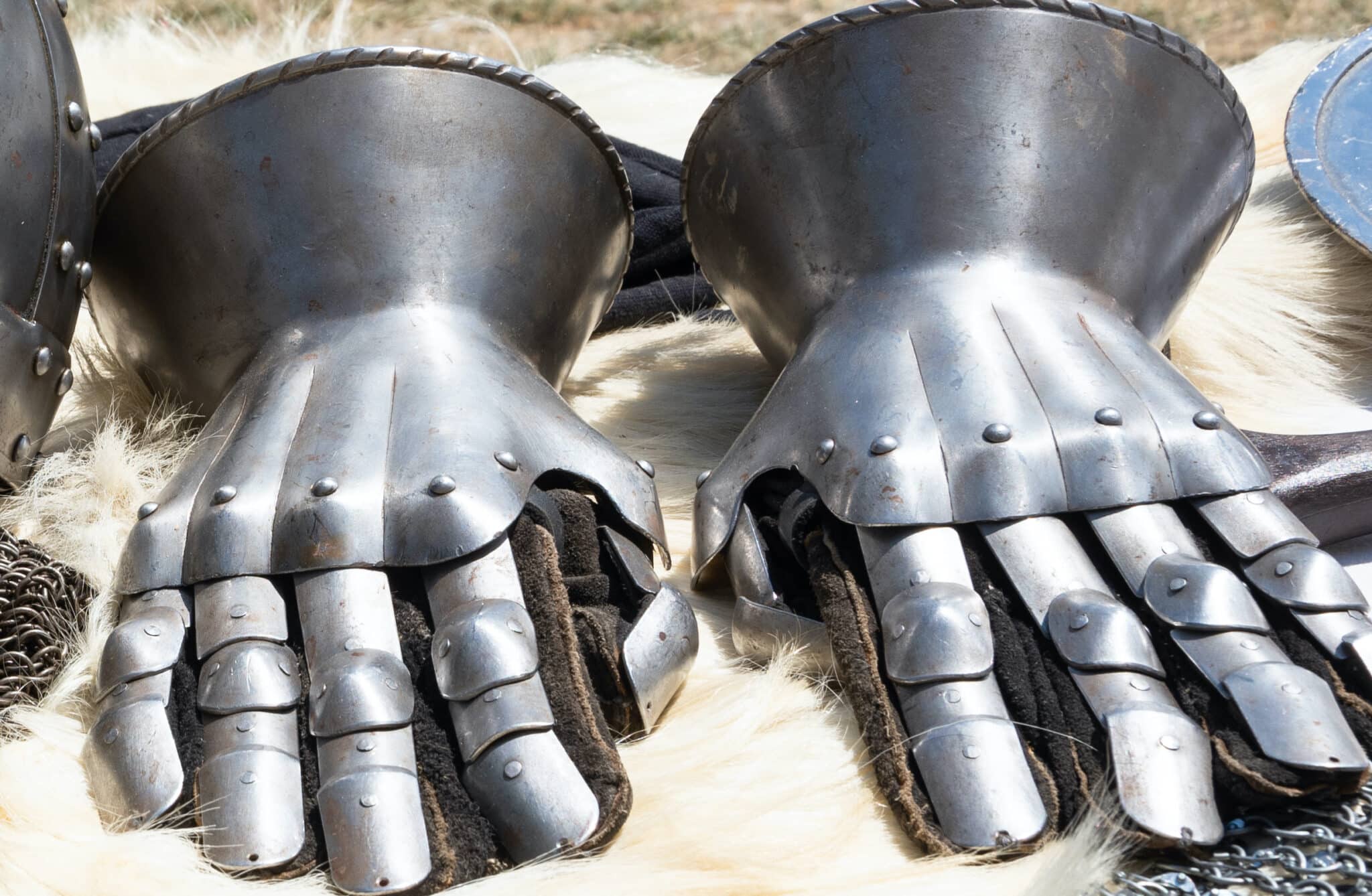 Gauntlets
Gauntlets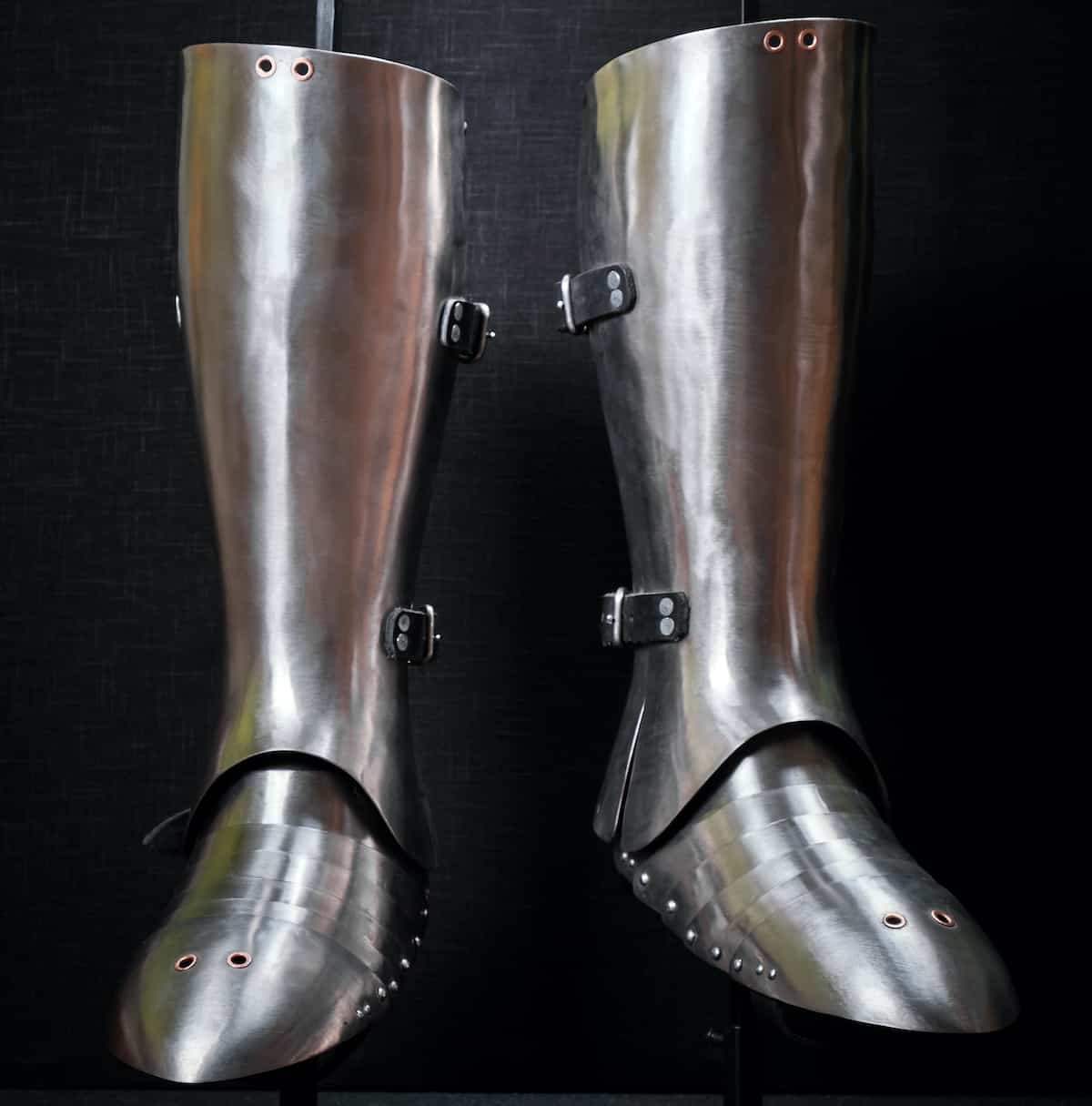 Leg Armor
Leg Armor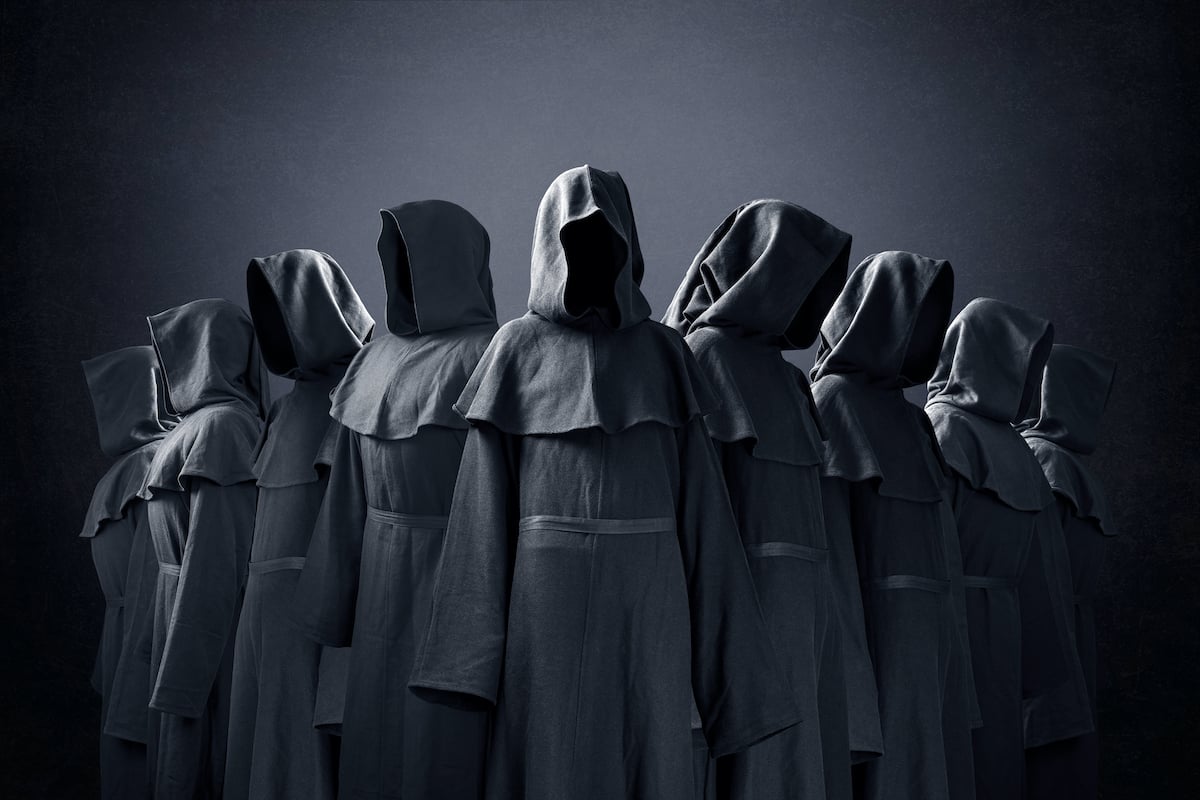 Cloaks
Cloaks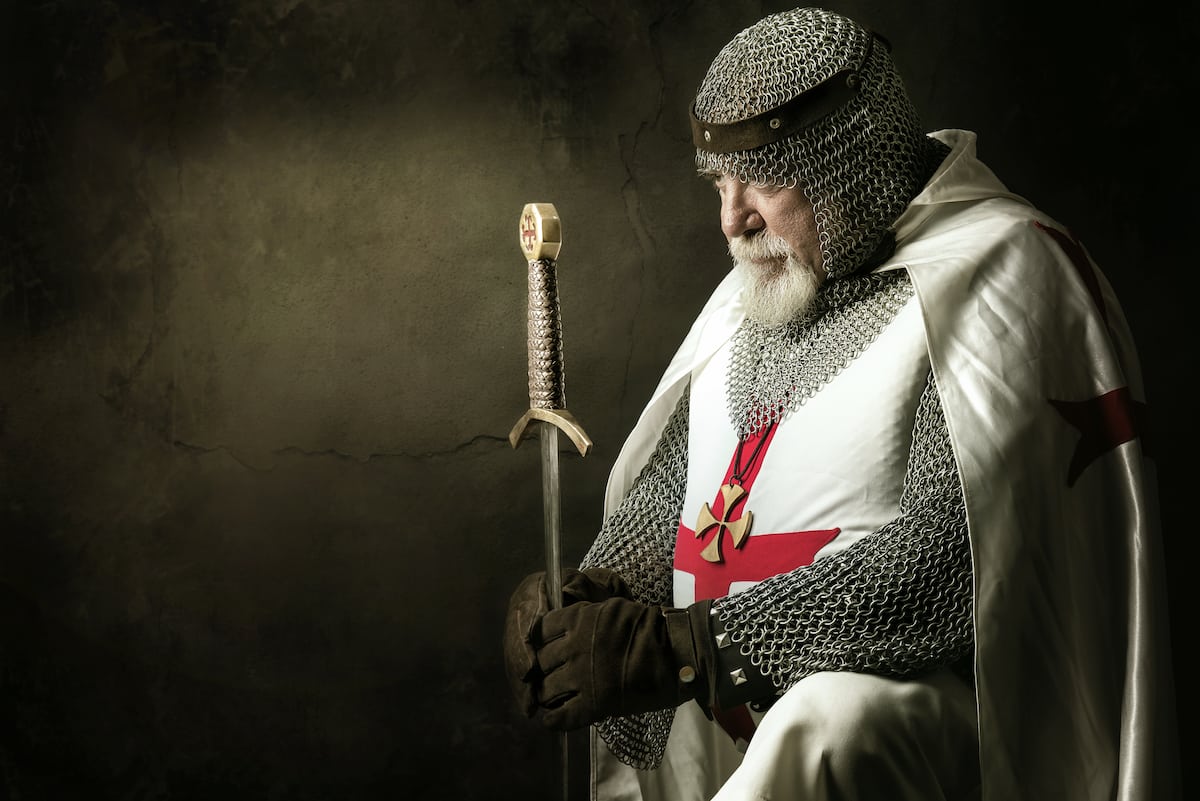 Tabards
Tabards Shirts
Shirts Tunics
Tunics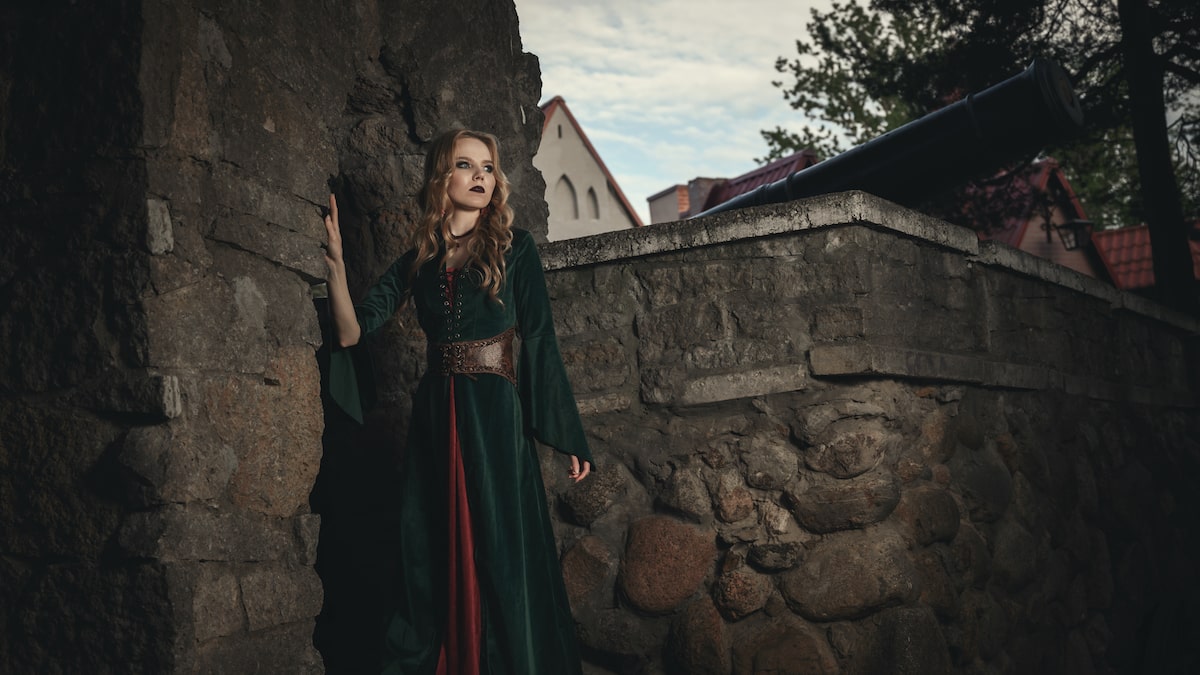 Dresses
Dresses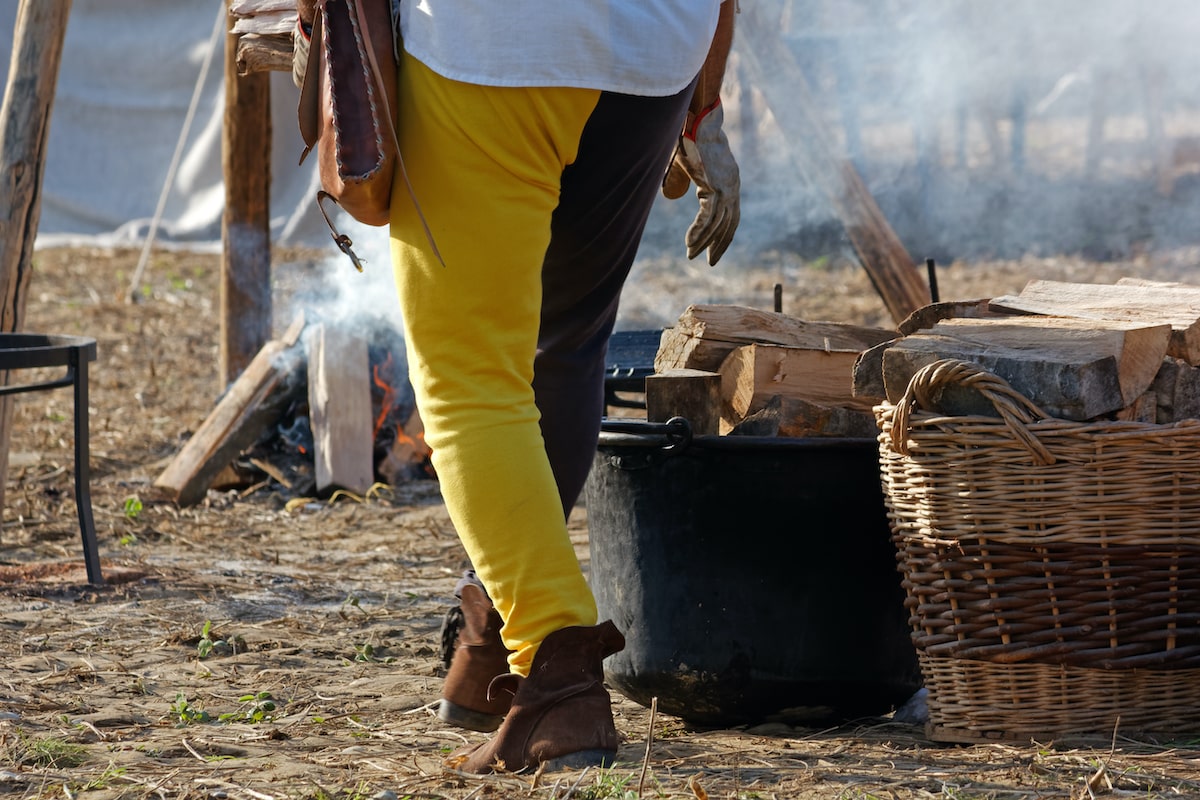 Pants
Pants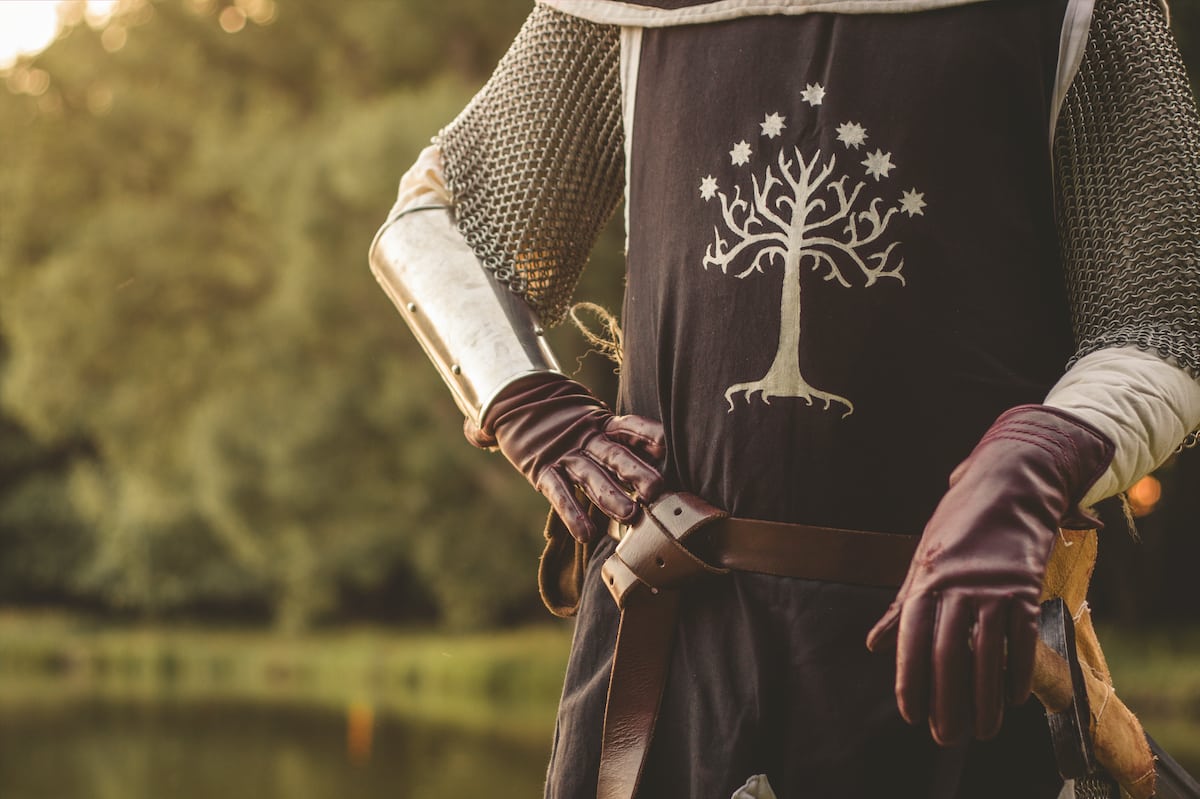 Gloves
Gloves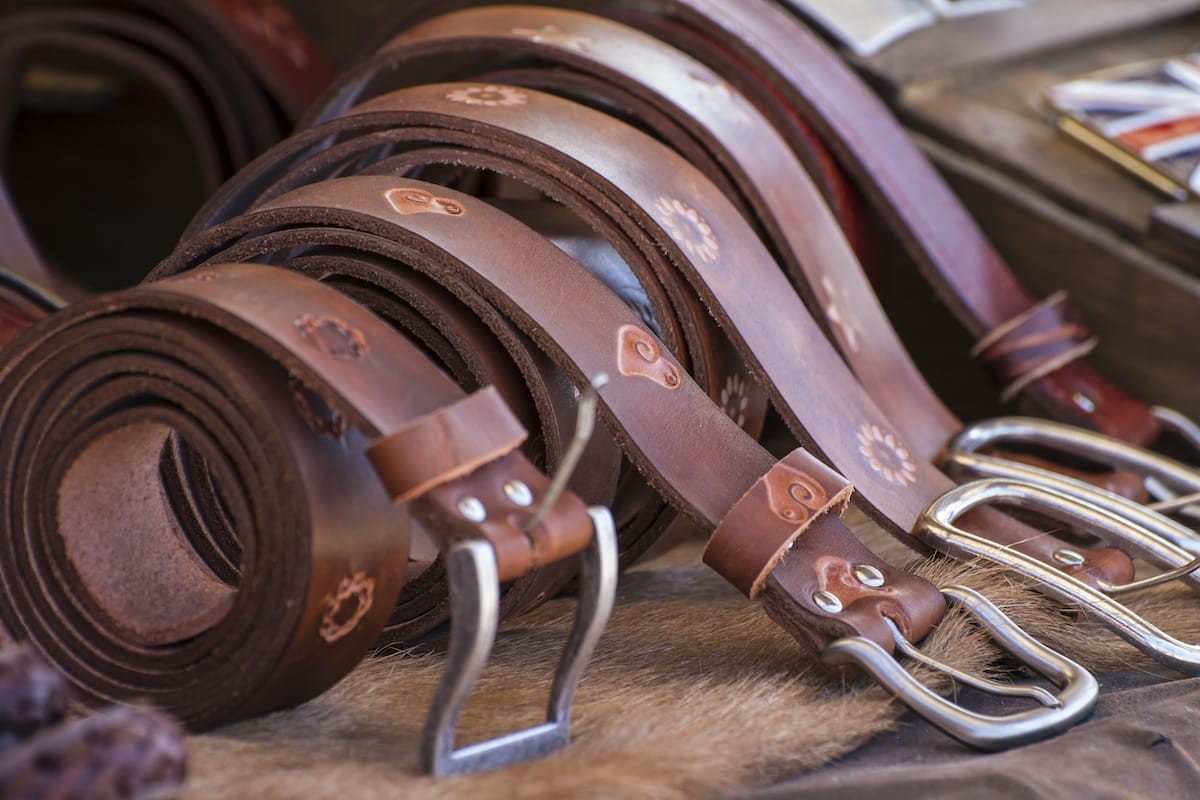 Belts
Belts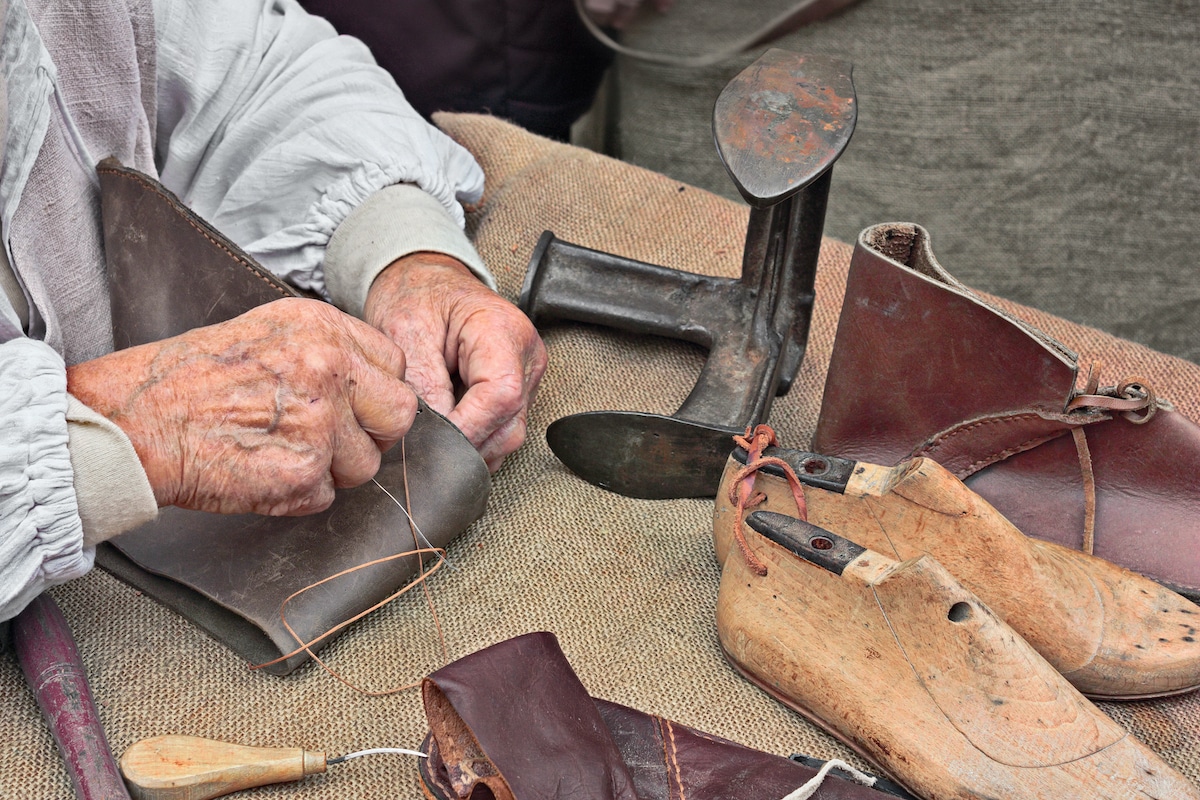 Shoes
Shoes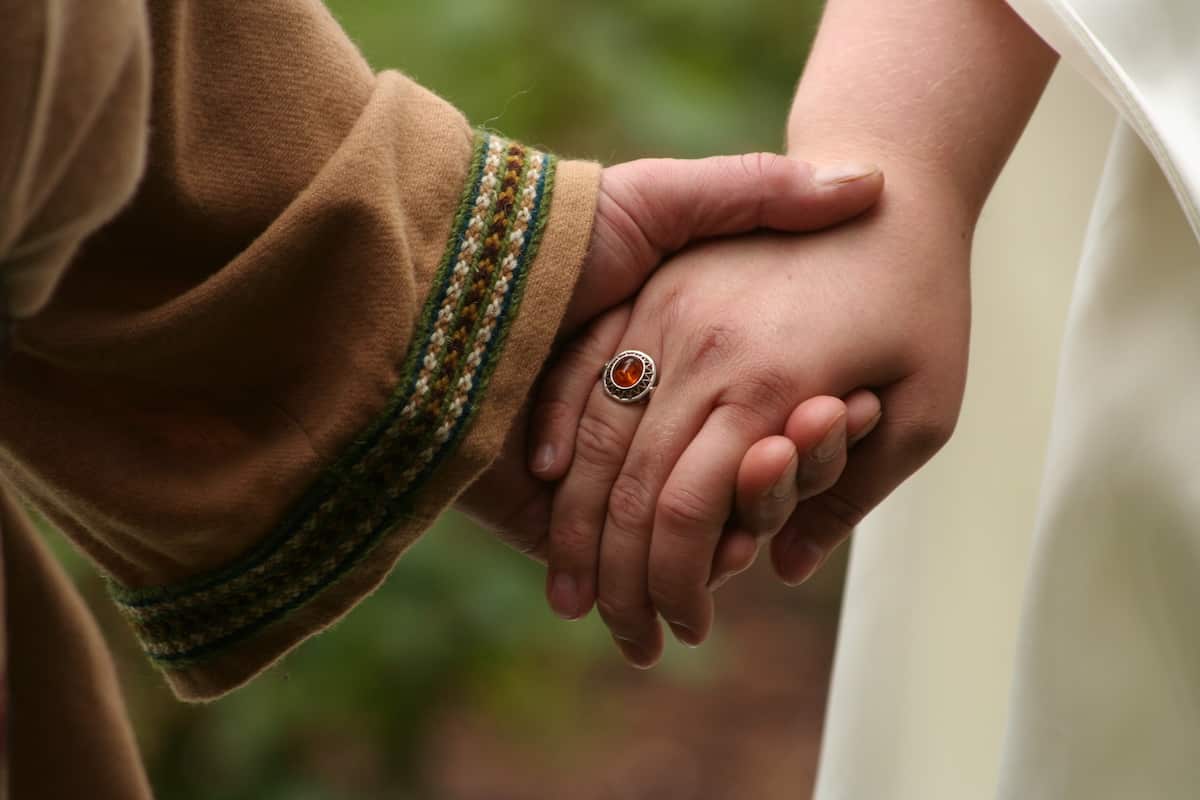 Rings
Rings Necklaces & Pendants
Necklaces & Pendants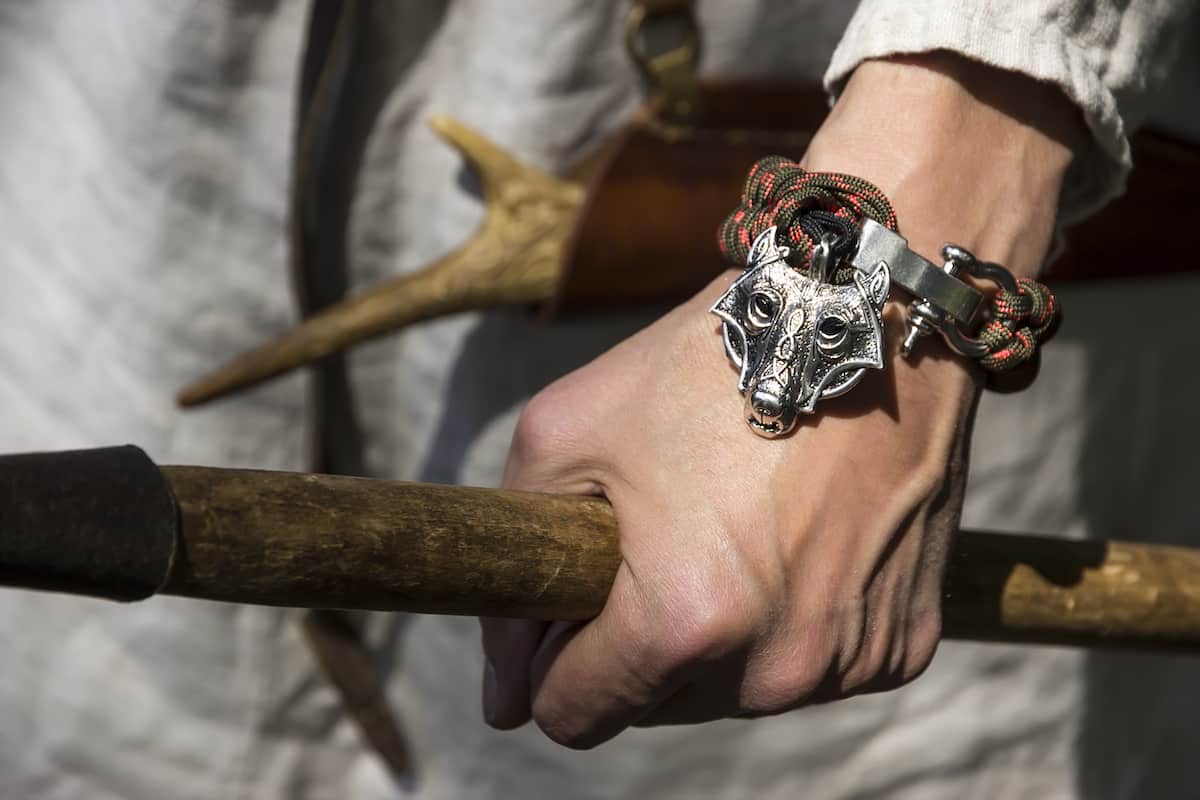 Bracelets
Bracelets